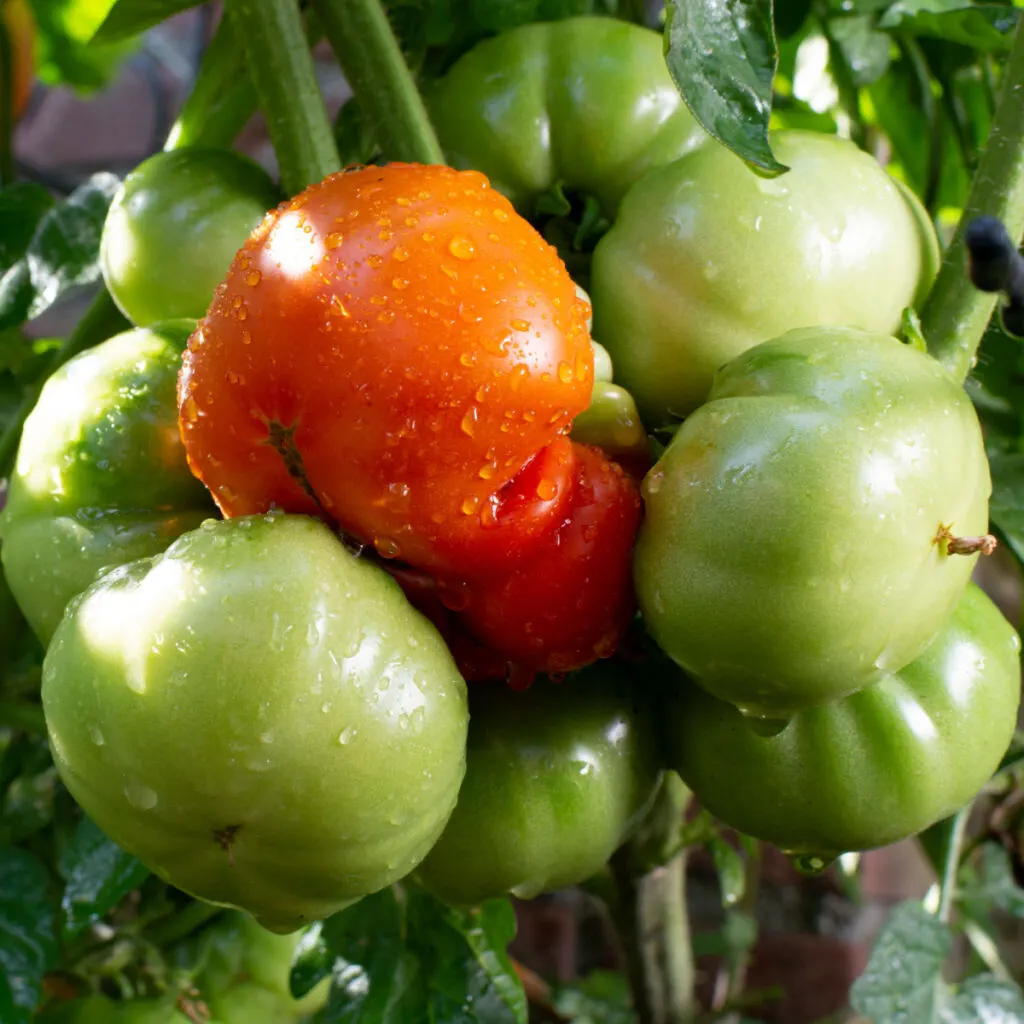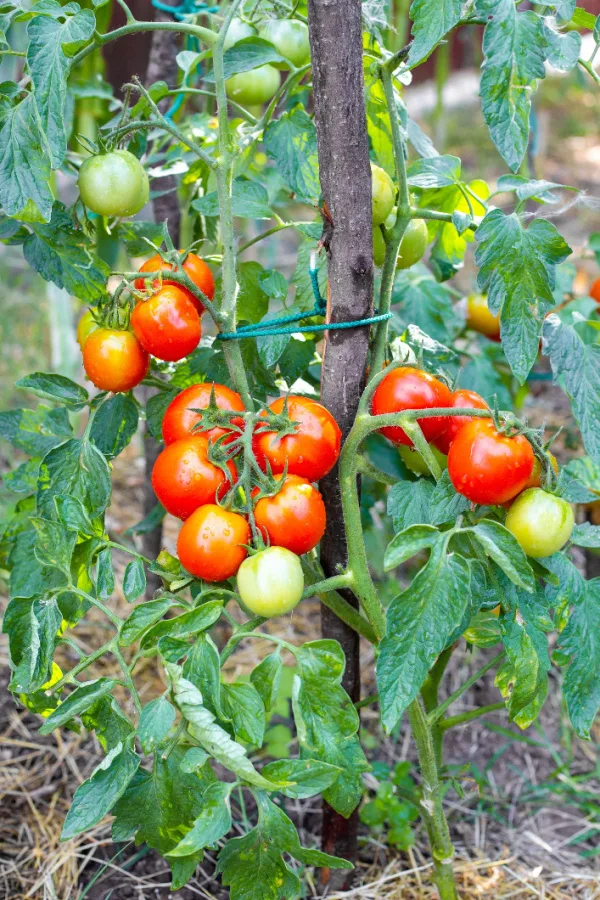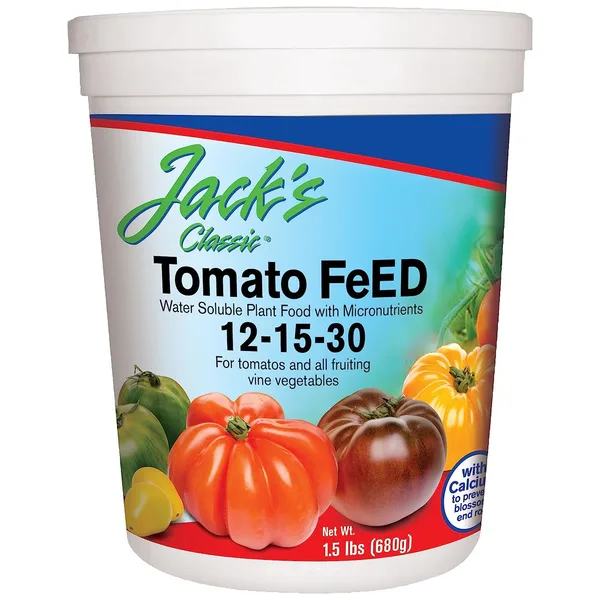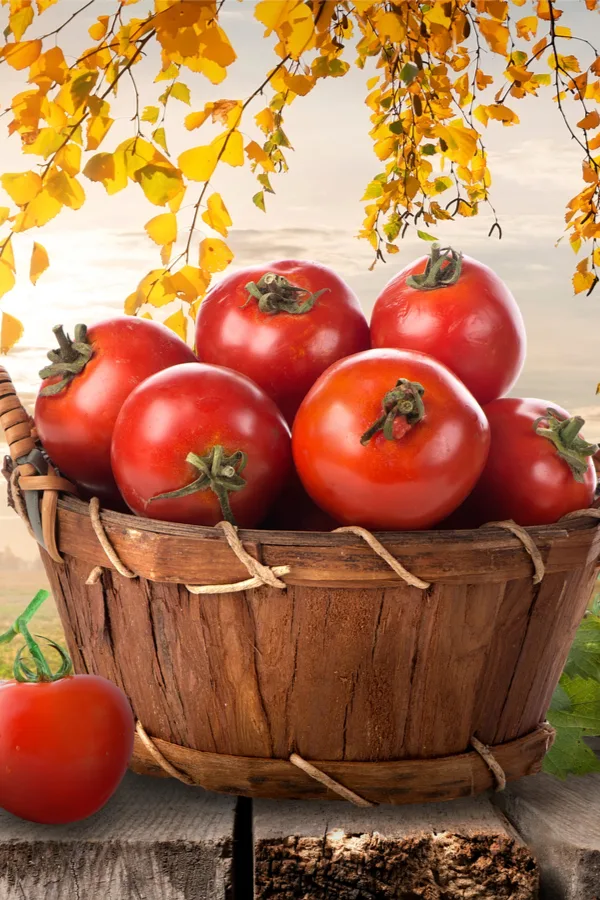How you fertilize your tomato plants during the summer months can play a critical role in just how many tomatoes your plants produce – and even more – for how long they will continue to produce late into the summer and fall.
Tomato plants are one of the heaviest feeding vegetable plants a gardener can grow. Not only do they require a tremendous amount of nutrients to develop strong roots, branches and foliage early in the season, they need even more to then flower and fruit.
Because of that massive need for nutrients, tomato plants often deplete the soil of energy by the time summer arrives. Unfortunately, that also happens to be exactly when they need power more than ever in order to fruit!

Why To Fertilize Tomato Plants In The Summer
When tomato plants run out of energy from the soil, not only can it affect their production, it can also affect their health. Plants that lack energy begin to lose their vitality and strength. In short order, their roots weaken and shrivel. And with feeble roots, the stems and foliage begin to suffer quickly as well.
As they weaken, the plants then become an easy target for disease and pest attacks. Before long, without a source of additional nutrients, plants simply wither away – and end their production long before summer is over. Unless, of course, you can power them up with the perfect dose of energy all summer long!
How To Fertilize Tomato Plants In The Summer – 3 Simple Secrets To Success!
There are three simple but extremely important “secrets to success” when fertilizing tomato plants during the summer months.
The first is to give your plants the right type of energy they need to produce more blooms and tomatoes. The second is to make sure to give them that energy in a form they can easily and quickly absorb. And the third and equally important key is to provide your plants consistently and evenly with that power.

With those three critical needs in mind – here is an in depth look at how to perfectly power up your tomato plants during the summer to ensure a big harvest!
Selecting The Right Fertilizer – How To Fertilize Tomatoes In The Summer
First and foremost, it’s extremely important to select a fertilizer that has the right balance of nutrients for maximum production. For tomatoes, that means choosing a fertilizer that contains a higher balance of phosphorous and potassium and a lower dose of nitrogen. See our article: Understanding N-P-K
Nitrogen is important for a tomato plant’s growth and development. Especially early in the season as the plant fill out. But once summer arrives, feeding your plant a lot of nitrogen will only cause it to keep growing – and not focus on producing blooms or tomatoes.
Phosphorous and potassium on the other hand are exactly what your tomato plants need and crave to produce blooms and set fruit. Phosphorous is the critical nutrient for setting blooms and fruit. And although potassium helps with that as well, it is also extremely important for plant health and helping to turn the fruit as they ripen.
Listen In Below To Our Podcast On How To Prune Your Tomato Plants For Healthier Plants & Better Production!
Nearly all fertilizers will carry an N-P-K ratio on their label. The N-P-K ratio stand for the make-up percentages of the nitrogen, phosphorous and potassium levels within the fertilizer.
For best success, when selecting a fertilizer for your plants, look for a bloom or bud powering fertilizer with higher P&K numbers within the N-P-K ratio. This will allow your plants to be fed the best possible nutrients for maximum production. Product Affiliate Link : JR Peters 51324 Jack’s Classic 12-15-30 Tomato Feed, 1.5 lb
Selecting The Best Type Of Fertilizer – How To Fertilize Tomatoes In The Summer
Not only do you want to use a fertilizer that is more robust in its phosphorous and potassium levels, you also want those bloom building nutrients to be in liquid form.
Granular fertilizers certainly have their place in powering plants, but they tend to break down slowly over time as they leach into the soil. For tomato plants that are producing, granular fertilizers are simply too slow to really help power maximum fruiting.
Instead, liquid fertilizers are the way to go for fertilizing tomatoes in the summer. Liquid power can absorb into plants both through the roots and through a plant’s leaves. Not only that, but liquid also absorbs fast, going to work far faster than granular fertilizers.

When fertilizing with liquids, always try to fertilize early in the morning or late in the day. This will help protect the foliage from the sun’s rays, which can burn foliage with mid-day sun.
Fertilizing Consistently – How To Fertilize Tomatoes In The Summer
Last but not least, it is extremely important to be consistent and steady when fertilizing. It is far better to power your tomatoes more often (every 7 to 10 days) but with less energy each time than to give your plants a huge dose of energy once a month.
When tomato plants receive too many nutrients all at once, it can actually slow or even stop their tomato production. Instead of using the energy to set more blooms and fruit, they use all of it to simply grow larger. You end up with huge, dark green plants that look great but have no tomatoes!
But when plants are given a steady but lower dose of nutrients every seven to ten days, they use that low and slow power perfectly, using the energy to set more blooms and fruit instead of simply growing bigger.

Diluting The Dose
For best results, when using liquid fertilizer, mix the dose at half strength. At half strength, the fertilizer can be applied to plants every week to ten days. All without worry of overpowering them with too excess nutrients that will spur only growth.
The good news is that for indeterminate tomato types, the lower but steady stream of nutrients, plants will stay strong and steady all summer long, and even more, have enough energy to keep producing right up until the first frost.
Here is to fertilizing your tomato plants this summer – and to harvesting your best crop of tomatoes ever this year!
Follow Our Facebook Page For Great Gardening Tips And Advice! This Is My Garden Facebook Page
This Is My Garden is a garden website created by gardeners, for gardeners. Jim and Mary Competti have been writing gardening, DIY and recipe articles and books and speaking for over 15 years from their 46 acre Ohio farm. They publish three articles every week, 52 weeks a year. Sign up today to follow via email, or follow along!
